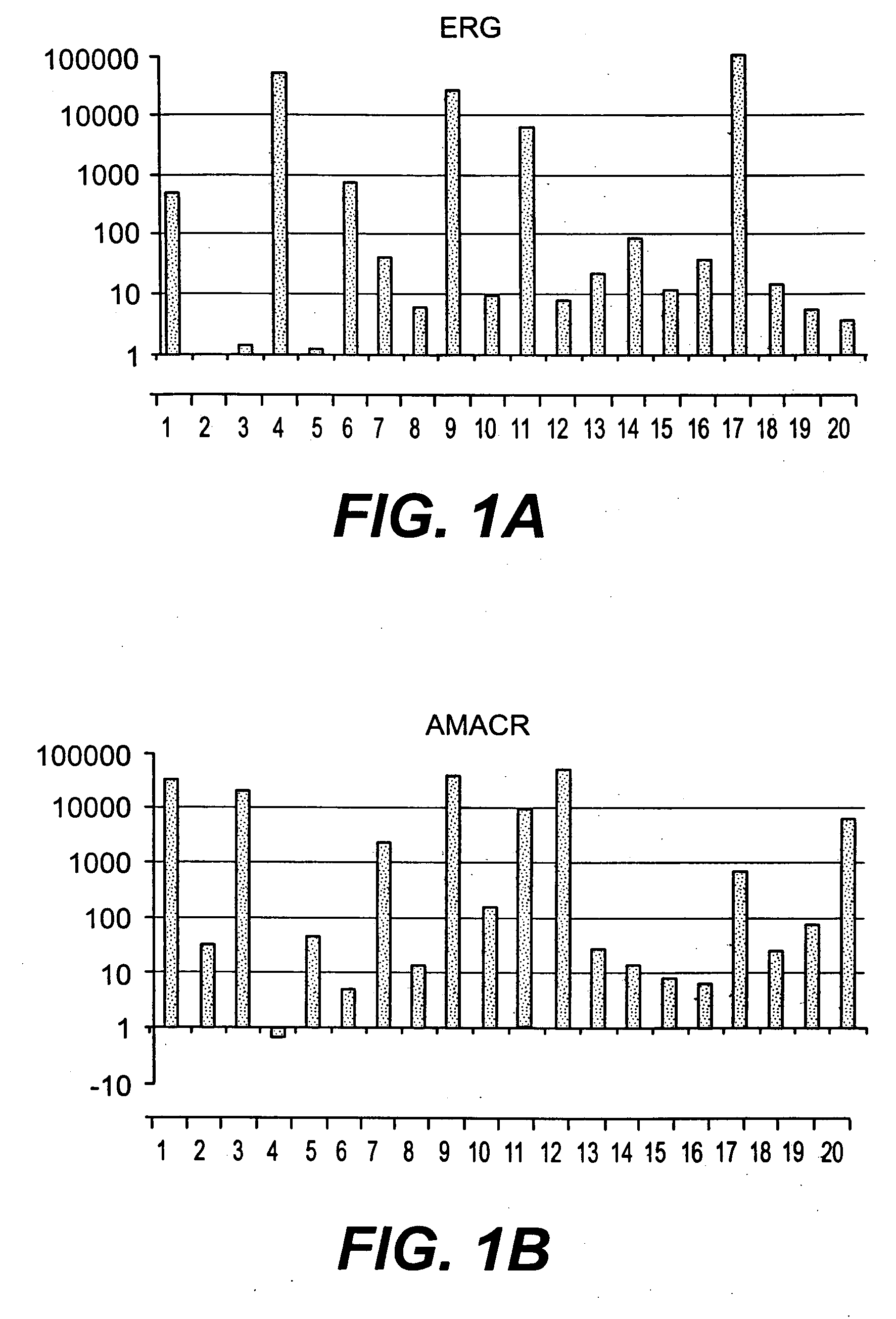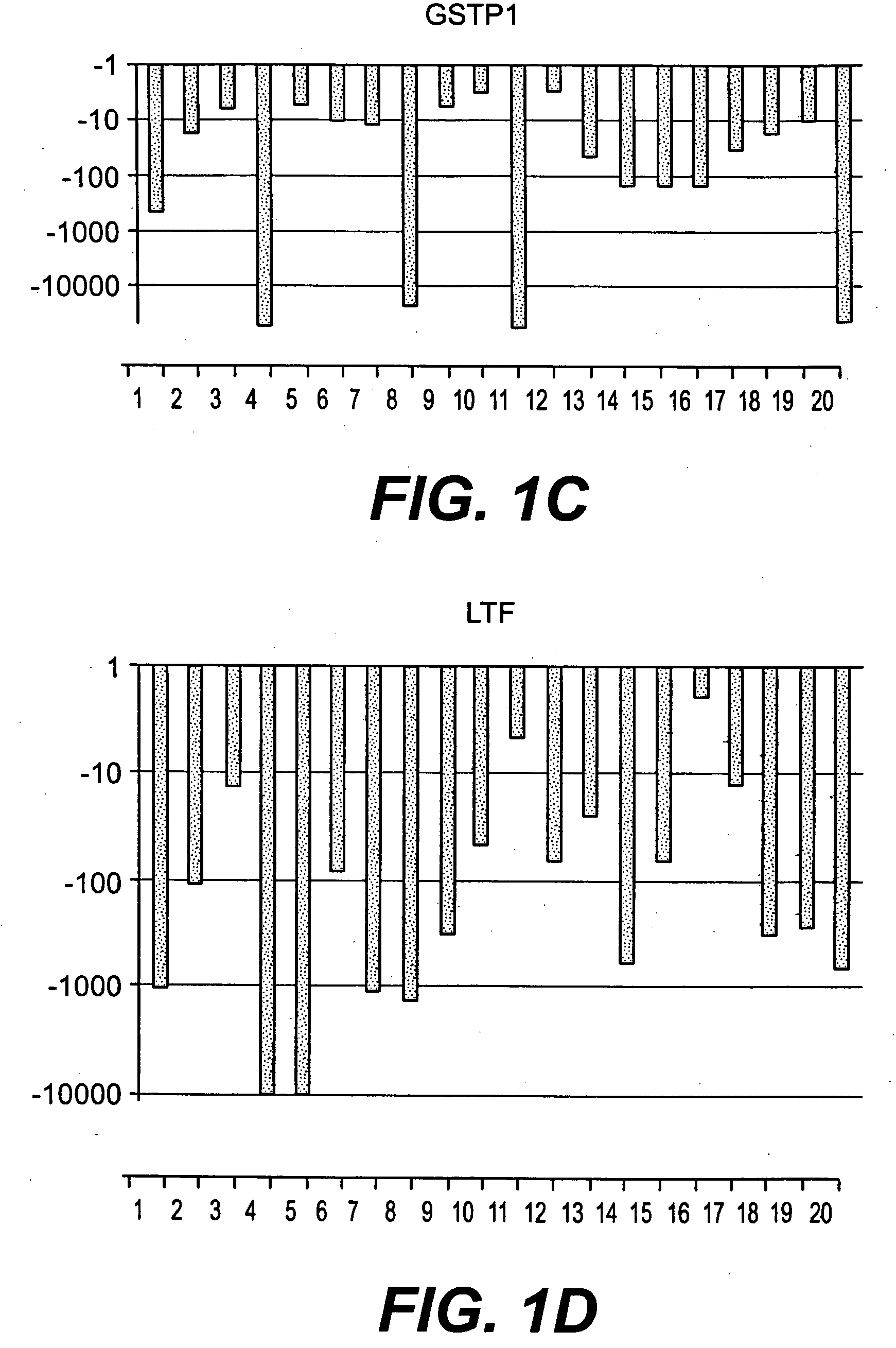Methods of diagnosing or treating prostate cancer using the erg gene, alone or in combination with other over or under expressed genes in prostate cancer
a prostate cancer and gene technology, applied in the field of prostate cancer diagnosis or treatment using the erg gene, can solve the problems of hampered molecular characterization of cap, limited application to identify patients at a greater risk of developing aggressive caps, and changes in human cap-specific epithelial and stromal cell-associated gene expression,
- Summary
- Abstract
- Description
- Claims
- Application Information
AI Technical Summary
Benefits of technology
Problems solved by technology
Method used
Image
Examples
example 1
Screening of CaP Cell-Specific Gene Expression Signatures Using Affymetrix GeneChip
Patient Selection
[0145]Specimens were obtained under an IRB-approved protocol from patients treated by radical prostatectomy (RP) at Walter Reed Army Medical Center (WRAMC). From over 300 patients two groups were selected which had prostate tumors with either moderate (MR) or high risk (HR) of disease progression after RP. The HR group had PSA recurrence, Gleason score 8-9, T3c stage, seminal vesicle invasion, and poorly differentiated tumor cells; the MR group had no PSA recurrence, Gleason score 6-7, T2a-T3b stage, no seminal vesicle invasion, and well to moderately differentiated tumor cells. LCM compatible specimens were selected from age and race matched HR or MR patients with no family history of CaP.
Tissue Samples and Laser-Capture Microdissection
[0146]Normal and cancer cells were laser capture microdissected (LCM) from OCT embedded and Hematoxylin-eosin (H&E) stained frozen prostate sections o...
example 2
Analysis of GeneChip Results by Supervised Multi-Dimensional Scaling (MDS)
Image Analysis and Data Collection
[0150]Affymetrix GeneChip Microarray Analysis Software, version 3.1 and Affymetrix Micro DB and Data Mining Tool version 2.0 (Affymetrix), Microsoft Excel 2000 (Microsoft, Seattle, Wash.) and Statistica version 4.1 (Stat Soft, Inc., Tulsa, Okla.) were used. In the Affymetrix system, the average difference fluorescence is the average of the difference between every perfect match probe cell and its control mismatch probe cell and is directly related to the level of expression of a transcript. A comparative file indicates the relative change in abundance (fold change) for each transcript between a baseline and an experimental sample. For further detail and advanced bioinformatic analysis we used the Microarray Data Analysis software from NHGRI and the GeneSpring software (Silicon Genetics, CA).
[0151]For clustering analysis, National Human Genome Research Institute (N...
example 3
Distinguishing Between ERG1 and ERG2 Isoforms
[0165]The Affymetrix GeneChip probe set (213541_s_at) and TaqMan probes used in the experiments described above recognize a region specific for both ERG1 and ERG2 isoforms (FIG. 6), but exclude isoforms 3 to 9. Although other primers and probes could be used, by way of example, TaqMan primers and probe recognizing both ERG1 and ERG2, but not other ERG isoforms were as follows:
Fwd primer:5′- AGAGAAACATTCAGGACCTCATCATTATG -3′(SEQ ID NO: 7)Reverse primer:5′- GCAGCCAAGAAGGCCATCT -3′(SEQ ID NO: 8)Probe:5′-TTGTTCTCCACAGGGT-3′(SEQ ID NO: 9)
The probe has the reporter dye, 6-FAM, attached to the 5′ end and TAMRA attached to the 3′ end. The 3′-TAMRA effectively blocks extension during PCR.
[0166]To further distinguish between these two ERG isoforms, the expression of the ERG1 and ERG2 isoforms were tested in PC3 cells and in normal prostate tissue (pooled prostate RNA from 20 men, Clontech), as well as in microdissected tumor and normal prostate epi...
PUM
| Property | Measurement | Unit |
|---|---|---|
| w/w | aaaaa | aaaaa |
| w/w | aaaaa | aaaaa |
| pH | aaaaa | aaaaa |
Abstract
Description
Claims
Application Information
 Login to View More
Login to View More - R&D
- Intellectual Property
- Life Sciences
- Materials
- Tech Scout
- Unparalleled Data Quality
- Higher Quality Content
- 60% Fewer Hallucinations
Browse by: Latest US Patents, China's latest patents, Technical Efficacy Thesaurus, Application Domain, Technology Topic, Popular Technical Reports.
© 2025 PatSnap. All rights reserved.Legal|Privacy policy|Modern Slavery Act Transparency Statement|Sitemap|About US| Contact US: help@patsnap.com



